Meridian programs and their unexpected Miraculous Effects
Dr. Cassandra Mougiakou, MD, Specialist in Internal Medicine, Athens, Greece
Dear Colleagues,
Before diving into the topic of my lecture, which is focused on using the meridian programs in our mission to help people and animals improve in their state of health, | would first like to take a step back and look into the history and creation of bioresonance therapy.
Bioresonance therapy emerged from observation and experience gained from the fields of:
Traditional Chinese Medicine and its teachings of the meridians and acupuncture points
Homeopathy
Electroacupuncture (developed by Dr. Voll and his addition of 8 more “vessels” to the classical TCM 12 meridians).
Dr. Franz Morell is the spiritual father of bioresonance therapy. It all began with testing of the acupuncture points. In fact, Dr. Morell was a member of a group investigating electroacupuncture testing under the direction of Dr. Voll since 1953. By 1957 he had started testing acupuncture points on patients with food intolerances while having them hold the specific food in question in
their hand during the testing process. In the case where the food was causing intolerance an “indicator drop” was observed which was then balanced by testing appropriate natural medicines.
In 1958 Dr. Morell went on to prove the effectiveness of correctly tested homeopathic agents by taking blood immediately before testing and observing the speed at which the blood sedimentation (BSR — blood sedimentation rate) fell. He repeated the same test 1-2 minutes later after injecting the tested homeopathic medication. If the medication was tested exactly the BSR improved by 30 to 70%. If the testing was not correct there was no improvement in the BSR. The observation was that just one minute after a subcutaneous injection a significant improvement could be observed in the BSR. However, the time it normally takes for subcutaneously injected medication to take effect is at least 20 minutes. Dr. Morell therefore concluded that there was some other force producing such an effect on the red blood corpuscles other than the biochemical one.
In 1972 Dr. Kramer reported that he was still able to test the medication himself if he placed a test ampoule in a metal test tube whose diameter was 4 mm larger than the ampoule and the information from the metal tube was fed to the patient through a wire. Dr. Kramer concluded that some form of electromagnetic oscillations similar to radio waves were present in the medication and that this radiation produced the phenomenon of medication testing.
Dr. Morell was fascinated by this phenomenon and 2 years later, in 1974, he succeeded in finally proving the electromagnetic nature of homeopathic medication with the aid of a medication test transmitter and receiver which he had asked his son-in-law Erich Rasche to develop for him.
Dr. Morell’s idea of bioresonance therapy was influenced by the following observations:
Homeopathic medicines are able to balance pathological values of acupuncture points.
Homeopathic medicines radiate electromagnetic oscillations.
These frequencies can be transmitted by wireless means.
The acupuncture points seem to show the same balancing effect when using electromagnetic oscillations transmitted by wireless means.
The oscillations from the medicines interact with the body’s oscillations which results in the phenomenon of the medication test.
This can be possible because electromagnetic oscillations of the same magnitude are present and active in the patient’s body.
Taking into account all of the above, it must also be possible to use the body’s own oscillations for the purposes of treatment by transmitting them back to the body.
Based on these observations, Dr. Morell hypothesized that by treating patients with their own frequency patterns using bioresonance therapy, it could potentially restore balance and alleviate health issues.
Since its very beginning, bioresonance therapy has been linked to the teachings of Traditional Chinese Medicine by testing the acupuncture points of the meridian system. And what would be more natural but to implement in the therapy the energy and information of the meridians themselves which are also part of the body’s magnetic field?
For each of the twenty meridians of the electroacupuncture system there is one pair of programs in the standard frequency range and one pair in the low deep frequency range. When it comes to the standard frequency range meridian programs, we know that one is for acute/inflammatory conditions when the reading on the electroacupuncture point is 55 and higher on the EAP clock and the other is for chronic/degenerative conditions when the reading is below 40. We have been taught to use the program that corresponds to the EAP reading on a specific meridian point. The handbook with the therapy programs explains the use of the meridian programs with the following options:
1. Application using the starting/terminal point of a meridian for acute and chronic states.
Input: Point applicator (knob or goldfinger applicator) on the starting/terminal point of the hand/foot.
Output: Modulation mat along the back.
2. Application via the meridian (so-called “meridian flooding”).
Input: Point applicator (knob or goldfinger applicator) on the starting/terminal point of the meridian.
Output: Point applicator (knob or goldfinger applicator), connected with a red cable to the red output sockets, on starting point of meridian (if necessary, change direction of flow) and, in addition, modulation mat along the back.
3. Application via both sides of the meridian following placement of applicators for the vessels according to Dr. Voll.
Input: Point applicator (knob or goldfinger applicator) on the acupuncture point with the highest value of one hand/foot.
Output: Point applicator (knob or goldfinger applicator) on the acupuncture point with the lowest value of the other hand/foot.
The BICOM® handbook of therapy programs also explains how to use the meridian programs to support their corresponding organs presenting them as “organ-related” programs. These meridian or organ-related programs are used to:
Stabilize and “open” (remove blockages) of the elimination organs.
Deliver organ-specific treatments.
In general, all meridian programs can be used in an organ-specific way to treat and stabilize the different organ systems. That brings us to the next way that the meridian programs can be used:
4. Application using the organs.
Input: Appropriate input applicator onto the corresponding organ.
Output: Modulation mat along the back or on the chest/abdomen, depending on the
place of the input applicator.
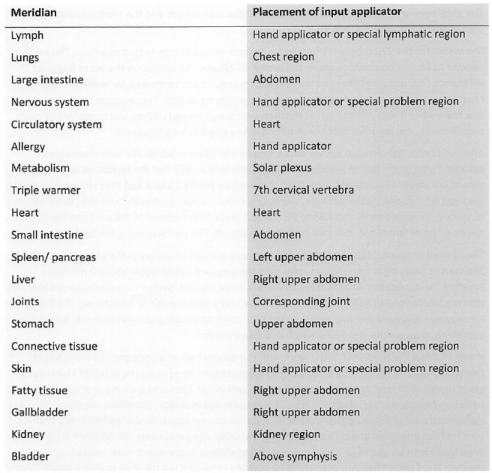
In the first couple of years of using the BICOM® bioresonance method | had been testing the EAP points and was taking these readings very much into account. | was registering their changes after running the basic therapy programs and was testing the suspected stressors on them. The
imbalanced meridian points were also giving me hints of the organ or system that seemed to have priority in therapy. However, EAP testing and re-testing of the imbalanced points requires a lot of time and my practice was becoming more and more busy so | switched to just using the tensor and later on, muscle testing as well. That means, that | would use the meridian programs, most often, for organ-related indications to help the elimination organs better detox the body (lungs, kidneys, large intestine, lymph). The only other way | would use them occasionally for was “flooding”, that is whenever | tested that this was the right thing to do. Let me give you a couple of examples of using the flooding technique.
A female patient reported she had itching on the sides of her nose, very often after eating. The area was in the vicinity of the terminal LI acupuncture point 20. | tested that, in fact, she needed the flooding therapy of the large intestine meridian. | started first with one side then the other. The goldfinger was used on the starting point on the index finger and the knob applicator on the area of the LI 20 point towards ST 3.
She tested for the 220 program which helps balance excess energy in that meridian. The input needed to be first on the area under the nostril (LI 20) and the output on the index finger (LI 1). After about 1,5 minutes | changed the applicators around and continued for another 45 seconds. | had the modulation mat on her back while the programs as well. The program made her shed a few tears while it was running (great reaction indicating release!). When she came for her next appointment, she reported that she didn’t have any more itching incidents.
Another female patient complained about frequent headaches which she was often able to associate with stress due to insecurity issues. She would mainly feel the headache on the right side of her forehead. | tested the bladder acupuncture points 1 and 2 and they were both weak on the right side, strong on the left side. The optimal therapy approach was to do the “flooding”. Acc. to testing, the input applicator had to be the BL 1 point (inner corner of the eye) and the output the BL 67 point (small toe, external side of the nailbed). The mat was along the back.
She needed program 391, which is used when there is a lack of energy in the bladder meridian. She started yawning almost immediately after the program began. After about 2 minutes | inverted the applicators and ran it for about one more minute. On her next appointment she said that the headache had subsided a great deal, she only had a few minor headaches. The flooding therapy was repeated one more time as the BL 1 point was testing somewhat weak. After that, she only had occasional headache which was much milder.
It was in about the third year of my work with the BICOM® when a male patient came to get therapy for pain in his right forearm. Since the very beginning of using the BICOM® | had reall great results with treating pain, especially musculoskeletal. | actually built my practice partially based on helping people wha had suffered from pain and mobility restrictions for years. So, | was quite frustrated when this patient came back for his second appointment and reported that his pain had not improved at all. That was in the year 2004 and | was using the BICOM® 2000. | didn’t have that many programs to work with (scar interference, tissue acute, wrist related, sports injuries) and | knew | had run everything he seemed to need. | got the idea to check which meridian was running through the area of his discomfort. | consulted the functional circuits and reflex zones poster which | have in my therapy rooms and saw that it was the large intestine meridian. | already had the medium applicator wrapped around his forearm on the area he felt the pain. | checked how the applicators should be placed for the meridian therapy and | got that they should remain as they were. Input on the problem area, mat on the back. He needed the program 221 for deficiency of energy. He felt the pain had subsided after the therapy was over. He came back one more time, reported he had been better and | basically repeated all | had done on the second session including the meridian program with the applicator on the problem area.
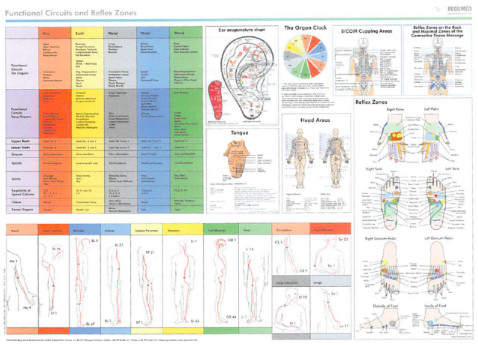
From then and on, | would remember my lesson. | would make sure to check the programs for the meridian that would be passing through an area of concern. | would do that while the input applicator would be placed on that area. As | was testing both programs available then, one for excess, the other for lack of energy | would soon find out that in the majority of cases, actually both programs were needed. That is similar to when both programs for tissue acute (922) and chronic (923) need to be used on a knee with osteoarthritis where there is inflammation in association with degeneration.
Energy should be flowing through a meridian like water through a hose. Whenever the hose will get twisted, the part of it above the twist has excess water while the part below doesn’t get enough water flow. Now, we have also been taught that “pain is the connective tissue’s cry for flowing energy” quoting Weichel. So, if we place the applicator on the area where the “twist” or, i.e., the block in the flow of energy is then it could well be that both programs (for both conditions) are needed.
One good example of using the meridian programs on the area that presents with symptoms is lower back pain. During a training, one of the attendees reported lower back pain. | placed the large flexible applicator over her lower back and the small modulation mat on the front of her body. | only tested and ran the bladder meridian programs as a start.

She actually needed all 4 bladder meridian programs, that is, the 2 in the LDF and X ) the 2 older meridian programs. The total running time for all 4 programs is 15 | minutes and this is how long her therapy took. Before | had realized the programs were over, she had removed the input applicator. | told her | intended to run more programs but she reported that the pain was gone.
Another quite fascinating result happened when | was treating an elderly woman with left knee issues. She was told that she needed a knee replacement surgery, however, we have been able to keep her in a good state with minimum discomfort. She does come back on a monthly basis as we are treating other conditions she has as well. In one session, she would point an area below the front inner side of her knee which was painful. | checked on the poster and saw that that area was
associated with the kidney meridian (however, no acupuncture points are found there).

With the input applicator (medium flexible) on that precise area and the mat on (Il the back | ran all 4 kidney meridian programs. | was quite surprised to receive a text message from her about 3-4 days after that session where she reported that her urinary incontinence was gone! Before she would need to go to the toilet very often as she would be afraid that she would have a leaking problem. We keep going back to running these programs from time to time just to maintain the result.

Another lady had a burning sensation on the inner side of her left calf. She would feel it on and off, and would usually be sitting when she had it. | placed the square flexible applicator on the area on which she would get that feeling and tested the meridian programs that she needed. It was the spleen meridian and | ran all 4 programs. After the first session she would get that burning sensation less often. About one month later we ran the programs one more time and after that she never felt it again.
A man who was attending a seminar reported chronic pain in the distant phalanx of his left index finger. He had seen a number of doctors who were not able to help him get rid of it. | placed the knob applicator on the acupuncture point of the nervous system meridian, which is located on the outer side of the nail’s bed and tested the corresponding meridian programs. He needed program 231 for chronic conditions. The man reported an improvement on the next day of the therapy. |
repeated the program once more 3 days later and his pain went away for good.
Another impressive example of using meridian programs is the case of a woman who had clicking in her left jaw joint. She also had pain in the upper part of her left shoulder blade. My testing showed a weak left TMJ and weakness in the area behind the left shoulder / upper shoulder blade. The priority in her case was to support the left shoulder’s rear area.

All 4 programs of the small intestine were needed for her therapy. | didn’t treat hero jaw joints on that day. At her next session, she reported that the clicking sound in) her left jaw joint was gone! Now, the terminal point of the small intestine meridian 1 (SI19) is located in a depression between the ear’s tragus and the jaw joint. It does | make sense to treat the small intestine acupuncture point 19 when treating the jaw joint which has chronic issues with the input applicator on the joint.

Women often report some discomfort or burning or pain on the outer side of one breast. That corresponds to the stomach meridian points 14-17. | place the square { flexible applicator on the problem area and have the mat on the back. | test all 4 meridian programs and run the ones that are needed. It usually takes 2-3 programs out of the 4.
There are 8 meridians which were added by Dr. Voll of which we do not know the exact course in the body. These are
Inthe hands: Lymph, Nervous System, Allergy, Organ degeneration (also referred to as Metabolism)
Inthe feet: Connective tissue, Joints, Fatty tissue, Skin.
| check their corresponding meridian programs with the input on the area of complaint. | will test the meridians that | believe are relevant to the tissue/problem | want to treat.
One common condition that people report is pain in their finger joints. In many cases astonishing and, often, instant results can be seen by using the joints meridian programs, especially program no. 3271.0, with the brass balls as the input and the mat on the back.
Patients with eye problems often benefit from using the lymph meridian programs with the eye mask as the input applicator. Some report an improvement in their close-up vision.
A man had pain in his spine due to metastatic cancer causing a fracture in his thoracic vertebra (TH10). Neither the bone pain nor the nerve pain programs seemed to be of any help and it wasn’t until the nervous system meridian programs were used (210, 211), with their running time being extended to quadruple their initial time that he finally had relief.
A woman patient had lymphatic oedema in her right lower leg (calf, foot) due to a gynecological procedure some years ago. Going my usual way of placing applicator(s) on the problem area and the mat on the back didn’t produce much of a result after the first session. So, in the second session, | tested that she needed an applicator (cylindrical brass applicator) on the right groin and the small mat was placed under her right lower leg. From that session and on she has had a significant improvement which lasts for about 3 weeks and that’s how often she comes back. | test and run all 4 lymph meridian programs which need their time to be extended by 4-5 times. | include the lymph support and lymphostasis complex substances from the second channel. Apart from the lymph meridian programs she also tests for the lymph activation programs 930, 830, 3066.0 and 610.
A woman with pain and restricted movement in her right shoulder came for therapy. She had that shoulder joint dislocated about a year ago. In the first three sessions the scar interference fields were treated along with programs for shoulder pain. The pain went away after the second session however on the fourth session she reported that there has been no change in the joint’s mobility.

I ran all 4 large intestine meridian programs and she could actually feel something y ; happening in her arm during that time. On the next day she reported back that she felt/_ her right arm “heavier”. On the day after that, she reported that she finally noticed a L& change in her mobility and she could raise her arm much higher. Other applications of the meridian programs are based on the energetic correlations between the meridian and organs/joints in the body.
It’s good to be aware of the energetic correlations between specific organs/joints and the meridian system. These correlations are shown in the table below.
Energetic correlations between joints and meridians
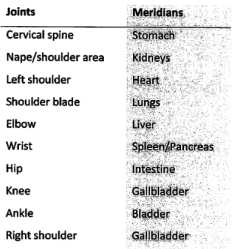
Input: appropriate flexible applicator on the joint (and, possibly, a second one on the meridianrelated organ).
Output: modulation mat on the back or the front of the body.
Taking these energetic correlations into account is beneficial in case of pain conditions of the joints. It’s often the case, that unless a meridian is not supported energetically, the pain condition will not improve. When treating people, | do take into consideration these energetic correlations alongside the course of the meridians.
In the table above, the first correlation we see is between the cervical spine and the stomach. In the case of dizziness which is not related to a cervical spine’s condition or ear problems | always go for the stomach meridian programs with the square flexible applicator as the input on the stomach. The same applies to headaches located in the entire forehead and behind the eyes.
Those can be due to hunger or anxiety, both linked with the stomach. | test, whether a second applicator should be used (eye mask). The second energetic correlation on the table is between the nape/shoulder area and the kidney meridian. When treating this area, | check whether to place the input applicator on the kidneys (waistline on the back) and/or on the nape/shoulder area. | check all 4 kidney meridian programs.
However, there is another meridian that goes over that area and this is the bladder meridian. In this case, | check all 4 bladder meridian programs with the input applicator on the problem area.
For faster use and easier access to the meridian programs | strongly recommend saving them as program sequences. In this way they can be reached with two clicks. Choose “4” from the main menu for program sequences, then “7” for own program sequences. This will take you to the screen with your own program sequences where you will be able to choose the sequence you need by its name (or number).
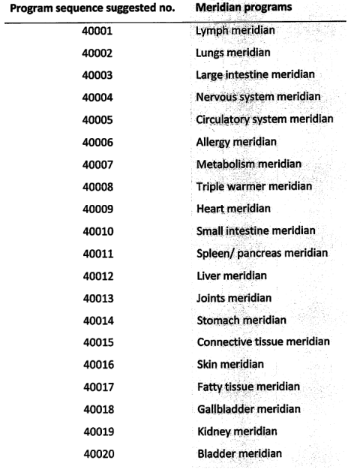
Summary
According to my experience of working with the BICOM® device, | find that putting the meridian programs into use can have astonishing results.
The 3 most frequent ways how | use the meridian programs are:
Apply the input applicator on the area which presents with signs of discomfort or skin issues (this is the most common application of the meridian programs in over 90% of cases).
Apply the input applicator on the starting point of the meridian and the output applicator on the terminal point and reverse the applicators after 1.5 minutes. This method is called “meridian flooding”.
Apply the input applicator on a starting or terminal acupuncture point of the meridian in question. [The starting and terminal points of each of the 20 electroacupuncture meridians are shown in the corresponding chapter in the manual with the therapy programs.]
| refer to the poster of the functional circuits and reflex zones poster which is in my therapy rooms to check which pathway out of the 12 classical acupuncture meridians is going over the problem area.
If none of the 12 classical meridians seems to fit, | will check the 8 additional meridians acc. to Dr. Voll depending on what is the problem (joints, connective tissue, fatty tissue for joint problems, allergy, skin and lymph for skin problems, lymph, fatty tissue, metabolism for abdominal issues, nervous system, lymph, connective tissue for any organ/tissue).
The BICOM optima® device has 4 stored programs for each of the meridians with a total running time of 15 minutes for all. However, it can be that the required time might be significantly longer. The sessions should be at least 1 week apart and usually only 2 applications of the programs are needed to balance the energy flow of the addressed meridian. If two sessions have not been enough to stabilize the energy in a meridian, a more in-depth evaluation should take place looking for other blocks and energetic stressors that might be affecting it.
